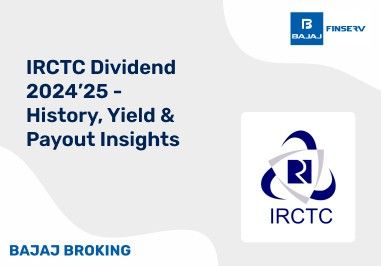In this article, we’ll explore what is IDCW in mutual fund. IDCW full form is Income Distribution cum Capital Withdrawal. It refers to a payout option in mutual funds where investors receive income and capital gains from the fund’s investments periodically. Unlike growth plans, IDCW distributes part of the returns, reducing the Net Asset Value (NAV) after each payout. IDCW meaning is ideal for investors seeking regular income. To explore IDCW options, consider opening a Demat account with Bajaj Broking and start investing.
What is IDCW Meaning?
IDCW meaning (Income Distribution cum Capital Withdrawal) in mutual funds represents a payout option where investors receive a portion of the income and capital gains from the fund’s investments. This payout can include dividends from underlying assets, capital appreciation or rental income. Instead of keeping the returns invested, IDCW mutual fund allows investors to receive them periodically, offering an alternative to growth plans where earnings compound without interim distributions. This feature is beneficial for investors who want a regular income stream from their investments while maintaining part of their capital in the fund. What is IDCW in mutual fund? It’s an option that combines income and capital withdrawal, helping investors understand that payouts may reduce the fund’s Net Asset Value (NAV) over time. With Bajaj Broking, investors can access a range of mutual funds with IDCW options to match their investment goals. By choosing IDCW, investors also benefit from the flexibility of retaining capital within the fund while receiving regular income.
How IDCW Mutual Funds Work?
IDCW mutual funds offer investors an effective way to generate income while retaining their capital. Let’s delve into how they function:
Income Generation: IDCW mutual fund investments generate income through dividends, interest and rental income from the fund’s underlying assets.
Capital Appreciation: In addition to income, mutual funds also experience capital gains when they sell assets at a higher price than purchased.
Distribution Mechanism: Under IDCW, these earnings are distributed to investors periodically—monthly, quarterly or annually.
NAV Adjustment: After each payout, the Net Asset Value (NAV) of the fund adjusts to reflect the distribution, often lowering NAV per unit.
Investor’s Choice: Investors in IDCW mutual funds have the flexibility to receive income while keeping part of their investment in the fund.
To explore these opportunities, it is crucial to open Demat account with Bajaj Broking, enabling you to access and manage your mutual funds effectively. Understanding IDCW meaning and its significance is vital for making informed investment choices.
Pros and Cons of Investing in IDCW Mutual Funds
Investing in IDCW mutual funds comes with its own set of advantages and disadvantages. Here’s a breakdown of the pros and cons:
Pros:
Regular Income: IDCW mutual funds provide a regular income stream, making them suitable for investors needing periodic cash flow.
Flexibility: Investors can receive part of their investment back regularly while keeping the remaining capital invested.
Transparency: SEBI’s IDCW nomenclature change clarifies that payouts include both income and capital, aiding informed decision-making.
Cons:
Reduced NAV: Each IDCW payout reduces the Net Asset Value (NAV), which might impact overall growth.
Tax Implications: IDCW payouts are taxable and can affect investors in higher tax brackets more significantly.
Lower Compounding Effect: IDCW mutual funds do not benefit from uninterrupted compounding, as dividends reduce NAV periodically.
Understanding these pros and cons can help you make informed choices about investing in IDCW and assess how it fits into your overall investment strategy.
How IDCW Impacts Your Mutual Fund NAV (Net Asset Value)
IDCW in mutual funds significantly impacts the Net Asset Value (NAV) by reducing it whenever there’s an income distribution. Each time a fund pays IDCW, the NAV decreases by the distribution amount per unit, as this payout is derived from the fund's returns or capital gains. For instance, if the NAV is ₹20 and the fund declares an IDCW of ₹2, the NAV will adjust to ₹18 post-distribution.
This adjustment can affect long-term compounding, as returns are periodically withdrawn rather than reinvested. While IDCW mutual funds provide a regular income stream, they also influence the investment’s growth potential due to these NAV reductions. Understanding IDCW meaning is essential for investors seeking to balance immediate income needs with long-term growth objectives.
Using Bajaj Broking, investors can track how IDCW impacts NAV in real-time, enabling them to make informed choices that align with their financial goals. To access mutual funds effectively, it's crucial to open Demat account with Bajaj Broking.
How to Invest in IDCW Mutual Funds
Investing in IDCW mutual funds can be a strategic way to generate income while growing your wealth. Here’s a step-by-step guide to help you navigate the investment process:
Research Funds: Start by choosing from a variety of IDCW mutual funds offered by Bajaj Broking based on your financial goals and risk profile. Understanding IDCW meaning will help you make informed decisions.
Open Demat Account: A demat account is necessary to invest in IDCW mutual funds. Bajaj Broking offers a seamless account-opening process, making it easy for you to get started.
Analyse IDCW Frequency: Select a fund that matches your desired IDCW payout frequency—monthly, quarterly or yearly—to align with your income needs.
Review NAV: Before investing, check the Net Asset Value (NAV) history and fund performance to ensure it meets your investment criteria.
Complete the Purchase: After reviewing all factors, complete the purchase through your Bajaj Broking account, enabling you to access and manage your mutual funds effectively.
Following these steps will help you successfully invest in IDCW and work towards your financial objectives.
Benefits of Investing in IDCW in Mutual Funds
Investing in IDCW within mutual funds offers several compelling benefits that cater to various financial needs. Here’s a look at some of the key advantages:
Regular Income: IDCW mutual funds provide consistent income, making them ideal for retirees or individuals seeking regular payouts to supplement their income.
Income & Capital Flexibility: The IDCW options allow investors to receive income without fully redeeming their investment, enabling them to maintain their capital while enjoying returns.
Investment Stability: By investing in IDCW mutual funds, investors can keep part of their principal in the fund while receiving payouts. This approach offers a balanced strategy for both growth and income, helping to mitigate risks.
Tax Advantage for Low-Income Brackets: IDCW payouts may be particularly beneficial for investors in lower tax brackets, as they can manage payout frequencies effectively to optimise tax liabilities.
These benefits make investing in IDCW an attractive option for individuals looking for a blend of income and capital preservation while aligning with their financial goals.
Methodology for IDCW in Mutual Funds
Understanding IDCW meaning (Income Distribution cum Capital Withdrawal) in mutual funds is crucial for Indian investors. Here’s a practical example illustrating what is IDCW in mutual fund schemes in a tabular format. Suppose you invest ₹1 lakh in a mutual fund with a Net Asset Value (NAV) of ₹5 per unit, giving you 20,000 units. The fund then declares an IDCW of ₹2 per unit, resulting in a distribution of ₹40,000 to you. Meanwhile, the NAV grows to ₹10 per unit, bringing your total investment value to ₹2 lakh.
If you choose to withdraw the IDCW amount, the new NAV (post-IDCW) drops to ₹8, adjusting your total investment value to ₹1.6 lakh. Platforms like Bajaj Broking can help you track IDCW declarations and their impact on NAV, aiding in more informed investment decisions. Here’s a breakdown of the process:
Date
| Particulars
| Amount (₹)
|
Purchase
| | |
Investment Amount
| | 100,000
|
NAV per Unit
| | 5
|
Units Purchased
| | 20,000
|
IDCW Declared
| | |
IDCW (₹2 per unit)
| | 40,000
|
Redemption
| | |
Current NAV
| | 10
|
Total Investment Value
| | 200,000
|
IDCW Withdrawal Amount
| | -40,000
|
Remaining Investment Value Post-IDCW
| | 160,000
|
Opening a demat account is essential for transacting in IDCW mutual funds and staying aligned with your financial objectives.
Factors to Consider Before Investing in IDCW in Mutual Funds
Before investing in IDCW within mutual funds, it’s essential to consider several key factors to ensure your investment aligns with your financial objectives. Here are the primary considerations:
NAV Impact: IDCW payouts reduce the Net Asset Value (NAV), which can affect the investment’s potential to compound over time. Understanding this impact is crucial for long-term investors.
Tax Implications: IDCW mutual fund payouts are taxed according to income tax brackets. It's important to consider your tax obligations, as this could influence your overall returns.
Payout Frequency: Choose an IDCW frequency that aligns with your income needs—whether it’s monthly, quarterly or annually. This flexibility allows you to manage cash flow effectively.
Capital Appreciation: Be aware that IDCW options might not grow as quickly as growth plans due to regular payouts, which can impact long-term growth potential.
Fund Performance: Always evaluate the past performance of the fund before investing in IDCW mutual funds. This analysis helps in selecting a fund with a solid track record that aligns with your investment strategy.
Risk Associated with IDCW in Mutual Funds in India
Investing in IDCW mutual funds in India comes with inherent risks that investors should be aware of. Here are the key risks associated with these investment options:
Market Risk: IDCW mutual funds are subject to market fluctuations that can affect the fund’s Net Asset Value (NAV) and subsequent payouts. This volatility can impact both income and capital.
Reinvestment Risk: Since IDCW payouts reduce NAV, this may lower the capacity for reinvestment, potentially affecting future returns. Investors relying on compounding might find their growth hindered.
Taxation Risk: IDCW payouts are taxable, which can significantly reduce net returns for investors in higher tax brackets. Understanding the tax implications is crucial for assessing overall profitability.
Capital Erosion: Frequent payouts from the principal can lead to capital erosion over time, particularly in volatile markets. This risk highlights the importance of balancing income needs with capital preservation.
Liquidity Risk: IDCW payouts are not guaranteed and depend on fund performance; poor performance may limit payouts, affecting cash flow expectations.
Being aware of these risks can help investors make informed decisions when considering IDCW mutual funds as part of their investment strategy.














